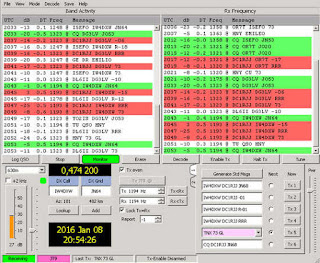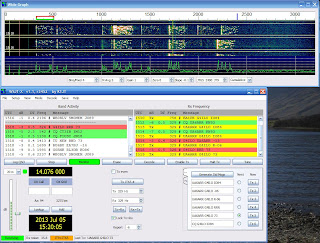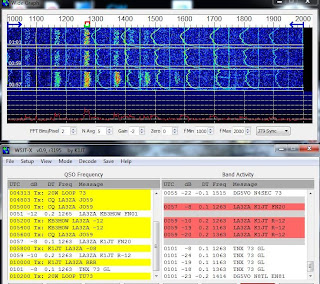Posts Tagged ‘JT9’
 Making Weak Signal QSO’s On 630m
Making Weak Signal QSO’s On 630m

As much as I love CW and try and promote its use on 630m, one cannot deny the growing interest and use of the WSPR mode on our newest ham band.
Its ability to dig deep into the noise and successfully decode signals as weak as -30db makes it an attractive method of watching the night-to-night and hour-to-hour propagation magic.
One only needs to check the number of stations logged into the WSPRnet Activity-page, uploading 630m spots each night ... a typical evening will see 60-80 calls listed.
The main problem with WSPR is that it's a one-way, beacon-only mode and it's not possible to utilize it for a valid two-way contact. It's nice to know that station 'A' is able to hear station 'B', and vice-versa, but the only way for both stations to know this is for them to both be monitoring the internet uploads ... if both stations were able to confirm their respective receptions all via radio, then a two-way contact could be claimed. Thankfully, there is another mode that solves this dilemma, without internet intervention and that's JT9.
JT9, developed by K1JT, is a spin off from his JT65 weak signal QSO-mode software developed for EME. JT9 has been tailored for the noisier HF and MF bands and is apparently, about 2db more sensitive than JT65. In the past, I have made several single-yagi EME contacts on 2m using JT65, with many of these QSO's being in the -27 to -29 db range. This would suggest that 630m JT9 contacts could be made at signal levels as weak as -30db!
A recent "630m Activity Weekend" in Europe turned out be a "630m JT9 QSO Party" with dozens of Europeans working each other throughout the event using this weak signal mode with great success. It looks very much as if JT9 may now be the go-to mode for two-way work on 630m when, as is often the case, signals can be easily seen on a visual waterfall display, but are too weak to be heard on CW.
 |
| DC1RJJ's 630m JT9 action courtesy: KB5NJD |
On this side of the Atlantic, recent JT9 contacts have been made between several of the U.S. experimental stations. WH2XCR in Hawaii (K9FD/KH6) and WG2XIQ in Texas (KB5NJD) worked on Dec 9th, while WH2XGP (W7IUV), WG2XSV (W0YSE/7) and others have been exploiting the power of JT9 to work around the country.
Such has been the case for me recently, with the arrival of VE3OT on 630m. Since beginning his nightly slow speed CW, QRSS6 beaconing, his signals have been easily visible here every night but only strong enough to hear aurally, on two occasions. It is likely that we could work each other fairly routinely on JT9 but will need to wait for very good conditions to work on CW.
The good thing about modes such as WSPR and JT9 is that they can be used without the need for linear amplifiers in the PA ... class D or E amplifiers, fairly universal in the LF/MF world, can be employed. The most popular route at present seems to be via a homebrew transverter that will allow the use of the station's main HF transceiver (using the tone-generating JT9 / WSPR software) to generate the required 630m RF.
I've been looking for a new radio workbench project to catch my interest and building a 630m transmitting converter is beginning to look more attractive, now that we have another DX target in VE3 land ... of course, if and when the U.S.A. gets the band, there will be an entire new crew of stations spread across the continent to keep the transverter busy!
 Doing the splits
Doing the splits
At the end of last month I was testing a new version of WSJT-X for Joe, K1JT, under NDA. The program has now been released, so I can write about it.
 |
| WSJT-X 1.1 can decode both JT65 and JT9 at the same time |
The major new feature is that WSJT-X 1.1 supports both JT65 and JT9. What is even more remarkable about it is that it can decode both modes at the same time! Enabling dual modes is optional, but if you use the feature and double-click on a station to reply to it the program will switch to the correct mode for the reply.
Another thing about this new version is that it can decode signals in a bandwidth 4kHz wide. If you have a transceiver that can receive such a wide bandwidth – Flex SDR radios can do this, as can the Kenwood TS2000 and my Elecraft K3 with FM filter installed – then you can take advantage of this capability. I didn’t think my K3 could go that wide, but all that was needed was to run the K3 Utility and enable the FM filter in DATA mode.
If you’re sharp then you will have thought of a snag. What happens if you reply to a station on the right hand side of the bandwidth? Receiving may be OK through the FM filter but on transmit the 2.7KHz SSB filter is used. The solution is clever: you keep the audio in the range 1 to 2kHz, engage SPLIT mode and set the transmit frequency to shift the signal up or down so that it matches the frequency of the station you are working.
I must admit that this perplexed me at first as I didn’t understand the significance of operating in split mode. My audio tones (heard with the K3 monitor turned up a little) were often lower or higher than the station I was replying to, and I was afraid I was replying on the wrong frequency. In fact, I was: I had forgotten to switch SPLIT on!
To avoid mistakes in future I created a Windows shortcut using a little utility I wrote to send a CAT SPLIT ON command before starting WSJT-X 1.1 and equally importantly, set SPLIT OFF when I had finished a session with WSJT-X. It’s just too much to expect me to remember to do this manually! I suggested to Joe that WSJT-X itself should send the split commands, but apparently it’s not that simple when you have to cater for every transceiver under the sun. So if you are working JT9 or JT65 and stations reply to you one or two kHz off-frequency don’t be surprised.
I should make it clear: WSJT-X 1.1 doesn’t decode both modes across 4kHz. It decodes JT65 in the lower half and JT9 in the upper half. You get to decide where the dividing line lies.
Joe K1JT thinks that JT9 users will move down a bit into the top end of the JT65 range, to enable people whose transceivers don’t give them 4kHz bandwidth to take advantage o9f the ability to work dual modes. In fact, at the moment, the result seems to be to have enabled JT65 users to spread out over 3kHz or more as is clearly illustrated by my screenshot. Time will tell.
 JT9 and 100 Hz ghosts
JT9 and 100 Hz ghosts
 |
| Multiple decodes at 100 Hz spacing of K1JT on 30 m on 28 April 2013, 0101 UTC |
From time to time I receive duplicate ‘ghost’ decodes at 100 Hz intervals on either side of the main signal. Last night I saw the phenomenon on 30 m. You will notice here that I have decoded the message: “TNX 73 GL” four times (press image for better readability):
- -24 dB, 1063 Hz
- -19 dB, 1163 Hz
- -8 dB, 1263 Hz
- -18 dB, 1363 Hz
See also “Overmodulated JT65 on HF?
 JT-Alert for WSJT-X
JT-Alert for WSJT-X
The eagerly awaited JT-Alert for WSJT-X has finally arrived! You can download it from the Ham Apps website.
This useful accessory will let you know if you have worked a station B4 or whether a station will fill a wanted band or mode slot. It sends spots of JT9 stations to the HamSpots website, providing a useful reverse beacon for the mode. It also logs contacts to a few of the popular logging programs including MixW which happens to be the same log format used by KComm. Due to some nifty programming this new version of JT-Alert works with JT65-HF as well.
This new program couldn’t come soon enough for me as I have worked just about everyone who is on JT9 at the moment and it was getting tiresome doing manual log lookups. Hopefully this new program will attract some new participants to this amazing mode.
 W(h)ither JT65A?
W(h)ither JT65A?
I was looking at all the stuff in my ham software folder and thought about deleting JT65-HF. I no longer see the point in continuing to use JT65A when an alternative exists which uses the same messages and takes the same amount of time but is more sensitive and much narrower. The fact that this alternative has come along at the same time as W6CQZ, the author of JT65-HF, has stated that he can no longer develop it seems to me very fortuitous.
Okay, there are still a lot more stations to work with JT65A but that is surely only temporary. Like Tim, G4VXE I can see activity switching from JT65A to JT9-1 over time and JT65A activity on HF withering away from lack of use. JT65A has been a lot of fun but it can also be frustrating when you can’t find space to operate within it’s 2kHz or when a very strong signal stops the software from decoding anything. JT9-1 has people using too much power too, but the decoder seems more robust and a lot more stations can concurrently use the same bandwidth. It just seems an all round better solution.
I expressed this opinion in one of the Yahoo! groups this morning and several people replied to disagree with me. As one person put it “if I am half way to WAS (worked all states) using JT65A then I am not going to stop using it until I have finished it.”
To me, I can see no reason to continue using a mode once a better alternative exists, which is why I have no interest at all in using RTTY, for which there are several superior alternatives. The idea of making contacts just to put a tick in a box in a matrix ordered by band, mode and prefix/country/state makes me quite depressed. I will use JT9 until something even better comes along, after which I will lose interest in it just as I have lost interest in JT65A.
 Ghostly signals
Ghostly signals
I have been puzzled and mildly irritated by the ‘ghost’ traces that appear at plus and minus 100Hz when I receive a very strong signal with WSJT-X. Torben OZ1TMK wrote to me after we had a JT9-1 QSO to ask if his signal had been OK. He had received requests from a couple of local stations to reduce power because he was ‘causing harmonics’. I hadn’t noticed anything wrong with Torben’s signal but it hadn’t been strong enough. It looked to me as if it was the same effect I and a few other JT9-1 users had observed when very strong signals were received, so I decided to investigate.
I had a theory that the +/-100Hz spurious outputs ( +/-120Hz observed in the USA) were caused by ripple modulating the transmitted carrier. I used my general purpose signal generator, otherwise known as the FT-817ND, to transmit a low power carrier (CW key down) into an unscreened dummy load (Elecraft DL-1). I repeated this with the transceiver powered from my bench power supply and then on its internal batteries with the power cable removed. The results in the WSJT-X spectrum display window are shown below.
 |
| K3 RX, FT-817 TX on mains supply. |
 |
| K3 RX, FT-817 on battery power |
As can be seen, there are traces at +/-100Hz and at 100Hz intervals on both signals, but the ghosts seem a bit stronger on the signal when the TX is powered from the main supply.
I recalled an issue a few years ago when someone sending CW using their K3 had reports of spurious signals +/- the sidetone frequency. This turned out to be audio modulation of the synthesizer by the sound of the sidetone from the K3 speaker. Elecraft provided a fix in the form of a stiffener for the synthesizer board. My K3 is an old one and does not have this modification. You can see that the synthesizer is affected by physical vibration looking at the trace produced when I rapped on the K3 case.
 |
| K3 RX showing the effect of vibration (knock on the case) |
My K3 sits on a shelf next door to a heavy linear power supply. Could slight vibration of the mains transformer be modulating the receiver’s local oscillator so as to create weak sidebands at +/- double the mains frequency?
To answer that question I repeated the tests using my Elecraft K2 as a receiver, feeding the headphone output at low level into the cheap USB audio dongle I use for computer sound. You can see the result below.
 |
| K2 on RX, FT-817 on mains power. |
 |
| K2 RX, FT-817 on battery power |
You can see that the sidebands are much reduced when the signal is produced by a transmitter running on battery power. In fact, some weak +/- 50Hz sidebands are present – possibly the effect of 50Hz AC hum on the un-isolated cable used to connect the K2 headphone output to the sound card.
I’m not sure what to make of all this. It does appear that the ‘harmonics’ – which are really sidebands – that accompany a strong JT9-1 signal are caused mainly by AC ripple modulating the transmitted carrier, but that hum on the receive side can produce a decodable signal as well. The WSJT-X software is extremely sensitive and can detect these components even if they are 30dB or more below the fundamental carrier.
I would appreciate hearing of other theories or tests carried out to explain this phenomenon. It seems to be that this issue is going to be almost unavoidable when mains-powered equipment is used to generate signals that are decoded by very sensitive software.













